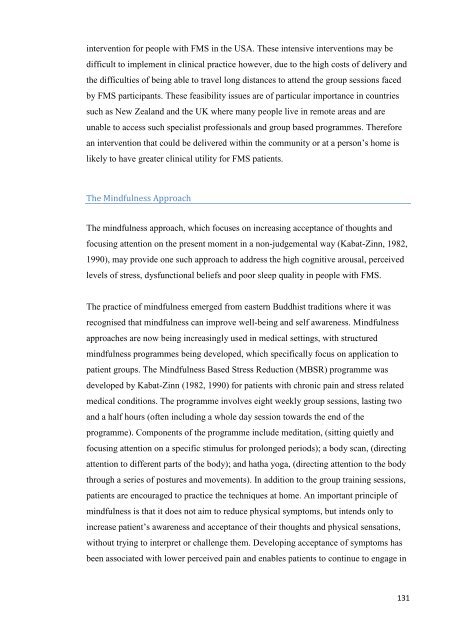Sick and Tired: Understanding and Managing Sleep Difficulties in ...
Sick and Tired: Understanding and Managing Sleep Difficulties in ...
Sick and Tired: Understanding and Managing Sleep Difficulties in ...
Create successful ePaper yourself
Turn your PDF publications into a flip-book with our unique Google optimized e-Paper software.
<strong>in</strong>tervention for people with FMS <strong>in</strong> the USA. These <strong>in</strong>tensive <strong>in</strong>terventions may be<br />
difficult to implement <strong>in</strong> cl<strong>in</strong>ical practice however, due to the high costs of delivery <strong>and</strong><br />
the difficulties of be<strong>in</strong>g able to travel long distances to attend the group sessions faced<br />
by FMS participants. These feasibility issues are of particular importance <strong>in</strong> countries<br />
such as New Zeal<strong>and</strong> <strong>and</strong> the UK where many people live <strong>in</strong> remote areas <strong>and</strong> are<br />
unable to access such specialist professionals <strong>and</strong> group based programmes. Therefore<br />
an <strong>in</strong>tervention that could be delivered with<strong>in</strong> the community or at a person‟s home is<br />
likely to have greater cl<strong>in</strong>ical utility for FMS patients.<br />
The M<strong>in</strong>dfulness Approach<br />
The m<strong>in</strong>dfulness approach, which focuses on <strong>in</strong>creas<strong>in</strong>g acceptance of thoughts <strong>and</strong><br />
focus<strong>in</strong>g attention on the present moment <strong>in</strong> a non-judgemental way (Kabat-Z<strong>in</strong>n, 1982,<br />
1990), may provide one such approach to address the high cognitive arousal, perceived<br />
levels of stress, dysfunctional beliefs <strong>and</strong> poor sleep quality <strong>in</strong> people with FMS.<br />
The practice of m<strong>in</strong>dfulness emerged from eastern Buddhist traditions where it was<br />
recognised that m<strong>in</strong>dfulness can improve well-be<strong>in</strong>g <strong>and</strong> self awareness. M<strong>in</strong>dfulness<br />
approaches are now be<strong>in</strong>g <strong>in</strong>creas<strong>in</strong>gly used <strong>in</strong> medical sett<strong>in</strong>gs, with structured<br />
m<strong>in</strong>dfulness programmes be<strong>in</strong>g developed, which specifically focus on application to<br />
patient groups. The M<strong>in</strong>dfulness Based Stress Reduction (MBSR) programme was<br />
developed by Kabat-Z<strong>in</strong>n (1982, 1990) for patients with chronic pa<strong>in</strong> <strong>and</strong> stress related<br />
medical conditions. The programme <strong>in</strong>volves eight weekly group sessions, last<strong>in</strong>g two<br />
<strong>and</strong> a half hours (often <strong>in</strong>clud<strong>in</strong>g a whole day session towards the end of the<br />
programme). Components of the programme <strong>in</strong>clude meditation, (sitt<strong>in</strong>g quietly <strong>and</strong><br />
focus<strong>in</strong>g attention on a specific stimulus for prolonged periods); a body scan, (direct<strong>in</strong>g<br />
attention to different parts of the body); <strong>and</strong> hatha yoga, (direct<strong>in</strong>g attention to the body<br />
through a series of postures <strong>and</strong> movements). In addition to the group tra<strong>in</strong><strong>in</strong>g sessions,<br />
patients are encouraged to practice the techniques at home. An important pr<strong>in</strong>ciple of<br />
m<strong>in</strong>dfulness is that it does not aim to reduce physical symptoms, but <strong>in</strong>tends only to<br />
<strong>in</strong>crease patient‟s awareness <strong>and</strong> acceptance of their thoughts <strong>and</strong> physical sensations,<br />
without try<strong>in</strong>g to <strong>in</strong>terpret or challenge them. Develop<strong>in</strong>g acceptance of symptoms has<br />
been associated with lower perceived pa<strong>in</strong> <strong>and</strong> enables patients to cont<strong>in</strong>ue to engage <strong>in</strong><br />
131

















